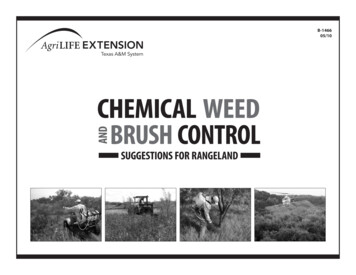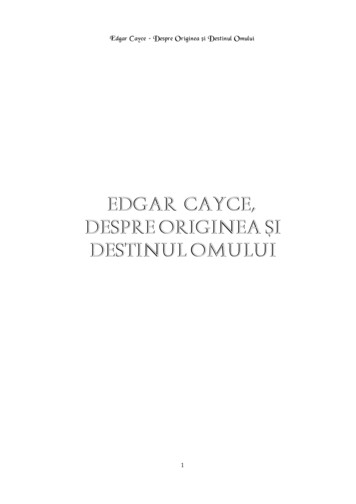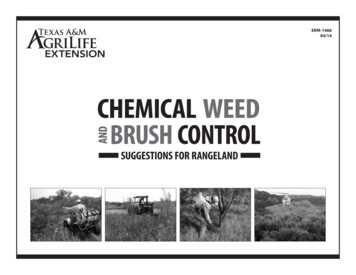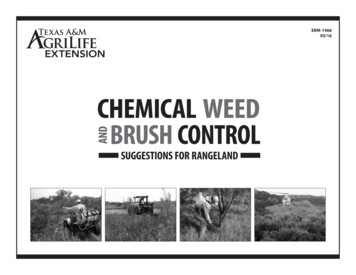
Transcription
B-146605/10
Chemical Weed and Brush ControlSuggestions for RangelandAllan McGinty, Jim Ansley, Wayne Hamilton,Charles Hart, Larry Redmon and Robert Lyons*This publication provides general suggestions for herbicides used to control brush and weeds on Texas rangelands. Italso gives information on the levels of control expected. The information is presented in good faith, but no warranty,express or implied, is given. Weed and brush control results may vary tremendously if treatments are applied under lessthan optimum conditions. Users of this publication may find the decision support system for rangeland weed and brushcontrol technology selection—Pestman—helpful. PESTMAN is designed to recommend appropriate mechanical andchemical rangeland brush and weed control treatments for Texas and New Mexico. All herbicide treatments includedin this publication are also included in PESTMAN, which helps in estimating costs and the economic impact of varioustreatment options. PESTMAN is an Internet-based system (http://pestman.tamu.edu) that can be accessed free of charge.*Professor and Extension Range Specialist; Professor and Research Scientist; Senior Lecturer; Professor and Extension RangeSpecialist; Professor and Extension Forage Specialist; and Professor and Extension Range Specialist, The Texas A&M System.
IndexControl descriptions for weed and brush plants are located on the page numbers indicated. Carefully check the chart. More than one control measure may exist.Weed speciesPageAfrican rue.8Berlandier lobelia. 8, 9Bitter sneezeweed . 8, 9Broomweed (annual or common). 8, 9Broom snakeweed. 9, 10Buffalobur. 8, 9Bullnettle.10Camphorweed. 8, 9Carolina horsenettle.10Cocklebur. 8, 9Common goldenweed.11Croton. 8, 9Dogfennel.10Drummond’s goldenweed.11Flathead sedge.11Garbancillo. 11, 12Gray goldaster.12Horehound. 8, 9Jimmyweed.13Lespedeza.12Marshelder. 8, 9Narrowleaf goldaster.12Perennial broomweed. 9, 10Plantain. 8, 9Prairie gerardia. 8, 9Ragweed. 8, 9Rayless goldenrod.13Rosin weed.10Silverleaf nightshade.10Smartweed. 8, 9Spiny aster.13Sulfaweed. 8, 9Sumpweed. 8, 9Sunflower. 8, 9Tallowweed. 8, 9Thistles. 8, 9Threadleaf groundsel.11, 12, 13Treadsalve.10Twinleaf (twoleaf) senna.13Upright prairie-coneflower.10, 14Western bitterweed. 8, 9Western horsenettle.10Western ragweed. 8, 9Wild carrot. 8, 9Wolfweed.13Woolly locoweed. 11, 12Yankeeweed.10Brush speciesPageAshe juniper.15Baccharis.15, 16Beebrush. 17, 33Beebush. 17, 33Bigelow shinoak.16Blackberry.17Blackbrush.16, 17, 28Blackgum.17Blackjack oak.17Blueberry cedar.15Bois d’arc.16, 17Burrobrush.17Catclaw acacia.16, 28Catclaw mimosa.16, 18, 28Cenizo.18Chinese tallowtree. 16, 18, 19Cholla.15Christ thorn .19, 24Common persimmon.19Creosotebush.19Dog cactus.15Dryland willow.15, 16Eastern persimmon.19Eastern redcedar. 20Elm.16, 20Flameleaf sumac. 20Giantreed.21Granjeno. 20, 28Greenbriar.16, 21Guajillo. 17, 28Hackberry.16, 17, 20Hardwoods. 17, 21Hercules club.16, 17, 20Honeylocust.21Huisache. 16, 20, 21, 22, 23, 28Lotebush. 17, 20, 22Macartney rose. 22, 23Mesquite.23, 24, 25, 26, 27, 28Mesquite, Western honey. 27Mixed brush – South Texas. 28Mixed brush – Davis Mountains. 28Mohrs shinoak. 28Post oak.17Pricklyash (Hercules club).16, 17, 20Pricklypear. 28, 29Redberry cedar.15, 30Redberry juniper.15, 30Retama. 22, 28Roosevelt willow.15, 16Running live oak.31Sacahuista.31Saltcedar.31Sand sagebrush. 32Sand shinnery oak. 32Saw palmetto. 32Seep willow.15, 16Skunkbush. 28Spiny hackberry. 20, 28Sweetgum.17Tarbush.19Tasajillo.15, 28, 29Texas persimmon.16Twisted acacia. 23, 28White shinoak.16Whitebrush. 17, 28, 33Whitethorn acacia.19Willow.17Willow baccharis.15, 16Winged elm.16, 17Yaupon.16, 20Yucca. 33
Millions of acres of Texas rangeland support an excessive cover of woody plantsand forbs. Dense stands of brush and weeds use valuable water for growth,reduce grass production and result in soil erosion. These noxious plants mustbe managed effectively for rangelands to reach their productive potential. Use of herbicides provides an effective and efficient alternative for controlling brush and weeds forimprovement and maintenance of rangelands in a highly productive condition.This publication lists current suggestions for herbicide use to control brush and weedson rangeland. Some herbicides provide a high degree of control of certain species; however, seldom is a species eradicated. Consider other potential rangeland uses when developing a brush management program. Many trees, shrubs and forbs are valuable as foodand cover for wildlife and may be an important component in livestock diets. Therefore,a brush management program should provide for use of control methods that give optimum benefits to livestock and wildlife.Herbicide application may increase palatability of poisonous plants. Thus, they are morelikely to be consumed by livestock. To prevent losses to toxic plants, herbicide-treatedareas with poisonous plants present should not be grazed until the toxic plants dry upand lose their palatability.Properly used herbicides are effective and safe. Misuse can result in poor brush andweed control and possible hazards associated with herbicidal drift, dangerous residues,or killing desirable plants. Listed below are points to follow for proper herbicide use: Identify the weed or brush species and evaluate the need for control. Consider expected benefits, costs and alternative control practices. Select and purchase the suggested herbicide for the weed or brush species. Read and follow herbicide label directions for allowable uses, application rates andspecial handling or mixing requirements. Provide and require the use of proper safety equipment. Calibrate spray equipment. Mix herbicides in a ventilated area, preferably outside. Spray under conditions that prevent drift to susceptible crops. Apply the herbicides at the suggested rate and time. Keep a record of the herbicide used, the time required to spray, weather conditions,rate of herbicide in carrier, date, location, and the person using the herbicide.IntroductionThe sprayer used must apply the correct quantity of herbicide mixture to a specific area.To calibrate spray equipment, see Extension publication L-5465, “Weed Busters: SprayerCalibration Guide.”Suggestions on use of herbicides made by the Texas AgriLife Extension Service are basedupon effectiveness under Texas conditions.Broadcast and individual plant treatments are presented in Table 1 and Table 2. Individual plant treatments are suited for control of thin stands of brush and selective control.Broadcast treatments are useful for dense stands of brush and for weed control.Suggested herbicides must be registered and labeled for use by the Environmental Protection Agency. Because the status of herbicide label clearance is subject to change, becertain that the herbicide is currently labeled for the intended use.The user is always responsible for the effects of herbicide residue on his livestock andcrops, as well as for problems that could arise from drift or movement of the herbicidefrom his property to that of others. Always read and follow carefully the instructions onthe container label.Treatment Control RatingsA control rating, based on the effectiveness of a herbicide treatment in controlling atarget plant, has been assigned to each herbicide use suggestion. These ratings weredetermined from research and result demonstration data and from observations of commercial applications. The rating represents a degree of plant mortality of the target plantspecies when the treatment is properly applied under optimum conditions. The ratingcategories and degree of plant mortality are:Control ratingPercent of plants killedVery high76-100High56-75Moderate36-55Low0-355
Common, Chemical and Product Names of Herbicides*Herbicide common nameChemical nameProduct nameActive ingredientor acid equivalentAminopyralid2-pyridine carboxylic acid, 4-amino-3, 6-dichloro-2-pyrdine carboxylic acid,triisopropanolammonium saltMilestone2 lb/galAminopyralid:2,4-D (1:8)See Aminopyralid and 2,4-DGrazonNext3 lb/galClopyralid3,6-dichloro-2-pyridinecarboxylic acidReclaim, Pyramid R&P, Clopyralid 33 lb/gal2,4-D(2,4-dichlorophenoxy) acetic acidWeedar 64,Broad Range 55, Hi-Dep,Weedone LV4, Esteron 99 and othersamine salts, free acids and estersof variable concentrationDicamba3,6-dichloro-2-methoxybenzoic acidBanvel, Clarity, Vision4 lb/galDicamba:2,4-D(1:3)See Dicamba and 2,4-DWeedmaster, Banvel 2,4-D, RangeStar,Outlaw4 lb/galDiesel fuel oil or kerosenerefined petroleum fractionsSeveral manufacturersFluroxypyr1-methylheptyl ester: etic acidVista XRT2.8 lb/galGlyphosateN-(phosphonomethyl) glycineSeveral including Rodeo**, Roundup,Roundup Ultradry, Glyphosate 417isopropylamine salt, concentrationvaries depending on the methyl-1,3,5-triazine-2,4(IH, 3H)-dioneVelpar L, Pronone Power Pellet2 lb/gal (Velpar L)75% (Pronone Power ethy)-5-oxo-lH-imidazol-2-yl]-3-pyridinecarboxylic acidArsenal, Habitat**2 lb/galMetsulfuron methylmethyl carbonyl]amino] sulfonyl] benzoateEscort, Clean Pasture, MSM 60DF60%Metsulfuron:Chlorosulfuron (3:1)See Metsulfuron methyl )aminocarbonyl]benzenesulfonamideCimarron Plus48% metsulfuron15% ChlorosulfuronMetsulfuron:Chlorosulfuron (1:1)See Metsulfuron: ChlorosulfuronCimarron X-Tra30% Metsulfuron37.5% ChlorosulfuronMetsulfuron methylDicamba:2,4-D(1:3)See Metsulfuron methyl, dicamba and 2,4-DCimarron Max60% (Part A)3.87 lb/gal (Part ylic acidTordon 22K, Triumph 22K, Picloram 22K2 lb/galPicloram:Fluroxypyr (1:1)See Picloram and FluroxypyrSurmount1.34 lb/galPicloram:2,4-D(1:4)See Picloram and 2,4-DGrazon P D, Gunslinger, Picloram D2.5 adiazol-2-yl}-N-N’-dimethylureaSpike 20P, Spike 80 DF20% (Spike 20P)80% (Spike 80 ic acidClear Pasture, Pathfinder II, TriclopyrR&PRemedy Ultra, Triclopyr 4 EC0.75 lb/gal (Pathfinder II–ready to useformulation for stem sprays)4 lb/gal (all others)Triclopyr:Fluroxypr (3:1)See Triclopyr and 1-methylhepty oxy)acetic acidPastureGard2.0 lb/galTriclopyr:2,4-D(1:2)See Triclopyr and 2,4-DCrossbow3 lb/gal*Herbicides have been identified by the accepted Weed Science Society of America common name, and when practical, one or more product names.**Aquatic label6Common, Chemical and Product Names of Herbicides
Common Measurement Conversions for Use with Herbicide ApplicationsLiquid1 gallon (gal) 4 quarts (qt)1 gallon 8 pints (pt)1 gallon 16 cups (c)1 gallon 128 ounces (oz)1 gallon 3784.96 milliliters (ml)1 quart (qt) 2 pints1 quart 4 cups1 quart 32 ounces1 quart 946.24 milliliters1 pint (pt) 2 cupsWeight1 pint 16 ounces1 pint 473.12 milliliters1 cup (c) 8 ounces1 ounce (oz) 2 tablespoons (tbs)1 ounce (oz) 29.57 milliliters1 tablespoon (tbs) 3 teaspoons (tsp)1 tablespoon 1/2 ounce1 tablespoon 14.79 milliliters1 teaspoon (tsp) 4.98 milliliters1 pound (lb) 16 ounces1 pound 453.6 grams (g)1 ounce 28.35 grams1 kilogram (kg) 2.2 poundsArea1 acre 43,560 square feet (sq ft)1 hectare (ha) 2.471 acresGuide to Quantity of Herbicide Formulation for Total Volume of Spray MixHerbicide Concentration Desired for Individual Plant and Spot TreatmentTotal SprayVolumeDesired1/4 %1 gal1/3 oz2/3 oz1 oz1 1/3 oz2 oz2 2/3 oz4 oz3 gal*1 oz2 oz3 oz4 oz*6 oz8 oz5 gal1 2/3 oz3 1/3 oz5 oz6 1/2 oz10 oz10 gal3 1/3 oz6 1/2 oz10 oz13 oz25 gal8 oz16 oz24 oz50 gal16 oz32 oz100 gal32 oz64 oz1/2 %3/4 %1%*1 1/2 %2%3%4%5%10%15%25%5 1/4 oz6 1/2 oz13 oz19 oz1 qt.12 oz15 1/2 oz19 oz38 oz57 oz96 oz13 oz19 oz26 oz32 oz64 oz96 oz1 1/4 gal19 oz26 oz38 oz51 oz2 qts.1 gal1 1/2 gal2 1/2 gal32 oz48 oz64 oz96 oz1 gal1 1/4 gal2 1/2 gal3 3/4 gal6 1/4 gal48 oz64 oz96 oz1 gal1 1/2 gal2 gal2 1/2 gal5 gal7 1/2 gal12 1/2 gal96 oz1 gal1 1/2 gal2 gal3 gal4 gal5 gal10 gal15 gal25 galQuantity of Herbicide Formulation*Example: To prepare 3 gallons of a spray mixture (herbicide, water and surfactant) containing 1% herbicide, add 4 ounces of herbicide.Note:Add 1/4 % to 1/2 % commercial, non-ionic surfactant for mixtures using only water as the herbicide carrier.Add 5% diesel fuel if an oil-in-water emulsion is the herbicide carrier. An oil emulsifying agent (emulsifier) should be added according to label directions. Agitation and the emulsifier are necessaryto prevent separation of the spray mixture.Caution:Non-ionic surfactants are not emulsifying agents and will not result in the formation of an emulsion when diesel fuel and water are mixed and agitated. The emulsifier should be added at 1 to3 ounces per gallon of the diesel fuel prior to adding the diesel fuel to the spray tank. The spray tank should be filled to about half the desired volume with water prior to adding the diesel fuelemulsifier premix. The diesel fuel-emulsifier premix is then added to the spray tank slowly, with agitation, after which the spray tank is filled to the desired volume with water.Common Measurement Conversions; Guide to Quantity of Herbicide Formulation7
Table 1. Herbicides for controlling weeds on rangeland.Weed controlledAfrican rueHerbicide (common andchemical names-page 6)Herbicide quantity(active ingredient rate in parenthesis)Broadcast rateper acreHexazinone liquidVH**2 ml/plantHexazinone pelletBerlander lobelia,bitter sneezeweed,broomweed (annual orcommon), buffalobur,camphorweed, cocklebur,croton, horehound,marshelder (sumpweed,sulfaweed), plantain(tallowweed), prairiegerardia (see remarks),ragweed, smartweed,sunflower, thistles,western bitterweed(see remarks), westernragweed, wild carrotand othersIndividual plant/spottreatment*Spray volume(per acre for broadcast, asdescribed for individualplant)Timeto applyUse an exact delivery handgun Spring or summer.to apply undiluted herbicide tosoil surface at the edge of theplant canopy.RemarksDo not use on heavy clay or caliche soils.1 pellet/plantTebuthiuron 20% pelletsH7.5 lb (1.5 lb)ImazapyrH32 oz (0.5 lb)VH0.5%10 to 25 gal/acre for groundbroadcast. Thoroughly wetfoliage for individual planttreatment. Add 32 to 64 oz ofsurfactant per 100 gal water.Late Septemberthrough October(to first frost).Applications should be made to fallregrowth that is in good growingcondition. Recommend using individualplant treatment when growing withdesirable vegetation to reduce non-targetdamage. Imazapyr is a non-selectiveherbicide and will kill or damage desirablevegetation if sprayed.2,4-D amine or low volatileesterVH**16 to 32 oz (1/2 to 1 lb)4 lb/gal productVH1% (4 lb/gal product)Dicamba:2,4-D(1:3)VH16 to 32 oz (1/2 to 1 lb)VH1%Spring, weeds 4 to6 in. high, goodmoisture condition.Spray thistles inrosette stage.Tank mix Dicamba with2,4-D amine or low volatileesterVH4 to 8 oz (1/8 to 1/4 lb)Dicamba 12 to 24 oz (3/8 to 3/4 lb)2, 4-D, 4 lb/gal productVH1/4 % Dicamba 3/4 % 2,4-D(4 lb/gal product)2 to 4 gal water for aerialspray; 10 to 25 gal water forground broadcast application.Thoroughly wet foliage forindividual plant treatment.Add 32 to 64 oz of surfactantper 100 gal of water.Picloram:2,4-D(1:4)VH16 to 24 oz (0.3 to 0.9 lb)VH1%VH8 to 24 oz (1/16 to 3/16 lb)Picloram 8 to 24 oz (1/4 to 3/4 lb) 2,4-D4 lb/gal productVH1/4 % Picloram 1/2 % 2,4-D(4 lb/gal product)Use 2,4-D amine in areas with 25 in. ofrainfall or more. Use 2,4-D low volatile esterin drier areas where no susceptible cropsare nearby. For western bitterweed controluse 2,4-D low volatile ester or amineat 32 oz/acre before plants flower andtemperature (above 72 F) and soil moisturefavor plant growth. When three-fourths ofplants are blooming and/or temperatureis less than 60 F, use Dicamba:2,4-D(1:3),2,4-D plus Dicamba, Picloram:2,4-D(1:4),Aminopyralid:2,4-D(1:8) or 2,4-D plusPicloram. For prairie gerardia controluse 48 oz/acre of 2,4-D or the low rate ofDicamba:2,4-D(1:3). Dicamba plus 2,4-D,Picloram:2,4-D(1:4) or Picloram plus 2,4-Dwhen plants are 4 to 6 in. high. Use 32 oz/acre of Picloram:2,4-D(1:4) or 8 oz of 2,4-D/acre when plants are 6 to 10 in. high beforeflowering.Tank mix Picloram with 2,4-Damine or low volatile esterMetsulfuron methylDicamba:2,4-D(1:3)VH**Rate 1 to Rate 2Picloram:Fluroxypyr (1:1)VH24 to 32 oz (0.25 to 0.33 lb)VH1%Use high end of rate range for camphorweed, marshelder and smartweed.Triclopyr:Fluroxypr (3:1)H32 to 48 oz (0.5 to 0.75 lb)VH1%Use high end of rate range forcamphorweed, marshelder andsmartweed. Triclopyr:Fluroxypr (3:1)efficacy on smartweed is marginal.*See Guide to Quantity of Herbicide Formulation for Total Volume of Spray Mix on page 7 for mixing information.**Treatment control ratings: VH – Very High; H – High; M – Moderate; L – Low8Table 1. Herbicides for Controlling Weeds on Rangeland
Weed controlledHerbicide (common andchemical names-page 6)Aminopyralid:2,4-D (1:8)Berlander lobelia,bitter sneezeweed,broomweed (annual orAminopyralidcommon), buffalobur,camphorweed, cocklebur,croton, horehound,marshelder (sumpweed,sulfaweed), plantain(tallowweed), prairiegerardia (see remarks),ragweed, smartweed,sunflower, thistles,western bitterweed(see remarks), westernragweed, wild carrotand others(continued)Broomweed (annualor common), plantain(tallowweed), wild carrotBroom snakeweed(perennial broomweed)Metsulfuron methylHerbicide quantity(active ingredient rate in parenthesis)Broadcast rateper acreVH32 oz (0.75 lb)VH4 oz (0.125 lb)VH0.1 ozMetsulfuron:Chlorosulfuron(3:1)VH0.125 ozMetsulfuron:Chlorosulfuron(1:1)VH0.2 ozPicloramPicloram:2,4-D(1:4)Picloram:Fluroxypyr (1:1)Tank mix Picloram with 2,4-Damine or low volatile ester.Dicamba:2,4-D(1:3)Tank mix Dicamba with 2,4-Damine or low volatile ester.Individual plant/spottreatment*VH16 to 32 oz (1/4 to 1/2 lb)VH1/2 %VH64 oz (1 1/4 lb)VH1%VH48 to 96 oz (0.5 to 1.0 lb)VH1%VH16 oz (1/4 lb) Picloram 16 to 32 oz (1/2 to 1 lb)2,4-D, 4 lb/gal productVH1/4 % Picloram 1/2 % 2,4-D (4 lb/galproduct)VH32 oz (1 lb)VH1%VH8 oz (1/4 lb) Dicamba 24 oz (3/4 lb)2,4-D, 4 lb/gal productVH1/4 % Dicamba 3/4 % 2,4-D (4 lb/galproduct)Spray volume(per acre for broadcast, asdescribed for individualplant)Timeto applyRemarks2 to 4 gal water for aerialspray; 10 to 25 gal water forground broadcast application.Thoroughly wet foliage forindividual plant treatment.Add 32 to 64 oz of surfactantper 100 gal of water.Spring, weeds 4to 6 in. high, goodmoisture condition. Aminopyralid provides excellent controlSpray thistles inof thistles and annual weed species inrosette stage.general, although at this time efficacy ofthis herbicide is not confirmed for all ofthe species in this list.2 to 4 gal water for aerial spray;10 to 25 gal water for groundbroadcast application. Add 32to 64 oz of surfactant per 100gal of water.Spring, weeds lessthan 4 in. tall.2 to 4 gal water for aerialspray; 10 to 25 gal water forground broadcast application.Thoroughly wet foliage forindividual plant treatment.Add 32 to 64 oz of surfactantper 100 gal of water.During and afterfull flower stage infall when growthconditions are good;or spring duringpeak plant growthwhen growthconditions are good.Add emulsifer to oil for proper emulsionwhen oil-in-water emulsion is used.Use 16 oz/acre of Picloram only in thefall. Use 32 oz/acre of Picloram in thespring. Poor control may be expectedif Dicamba:2,4-D(1:3) or Dicamba:2,4-Dmixture is used when growth conditionsare less than ideal. Growth conditionsshould be optimum if Picloram:2,4-D(1:4)or Picloram:2,4-D mixture is used in thespring.*See Guide to Quantity of Herbicide Formulation for Total Volume of Spray Mix on page 7 for mixing information.**Treatment control ratings: VH – Very High; H – High; M – Moderate; L – LowTable 1. Herbicides for Controlling Weeds on Rangeland9
Weed controlledBroom snakeweed(perennial broomweed)(continued)Herbicide (common andchemical names-page 6)Herbicide quantity(active ingredient rate in parenthesis)Broadcast rateper acreMetsulfuron methylVH0.6 ozMetsulfuron:Chlorosulfuron(3:1)VH0.75 ozMetsulfuron:Chlorosulfuron(1:1)VH1.2 ozMetsulfuron methylDicamba:2,4-D(1:3)Tebuthiuron 20% pellets2 to 4 gal water for aerial spray;10 to 25 gal water for groundbroadcast application. Add 32to 64 oz of surfactant or 2 galcrop oil per 100 gal of water.VH3.75 lb of pellets (3/4 lb)VH24 to 32 oz (0.25 to 0.33 lb)VH1/6 oz of pellets(1/30 oz) per 100 sq ftVH1%VH1/4 % Picloram 1/2 % 2,4-D(4 lb/gal product)RemarksOptimum time is inthe fall, but may beapplied in spring.Any time–optimum Use only on sand, loamy sand, sandy loam,loam, silt loam, silt or sandy clay loam soils.period is Oct. 1 toApril 1 except inTrans-Pecos whereoptimum period isMay 1 to July 1.2 to 4 gal water for aerialspray; 10 to 25 gal water forground broadcast application.Thoroughly wet foliage forindividual plant treatment.Add 32 to 64 oz of surfactantper 100 gal of water.Spring (seeremarks).Spray bullnettle, Carolina horsenettle,silverleaf nightshade and westernhorsenettle when plants begin to flowerin the spring. Spray dogfennel andyankeeweed when plants are 8 to 10 in.tall. Spray upright prairie-coneflower whenplants are 2 to 6 in. tall before flowering.VH1%Metsulfuron methylDicamba:2,4-D(1:3)H to VHRate 1 to Rate 2Dicamba:2,4-D(1:3)VH32 oz (1 lb)VH1%VH8 oz (1/4 lb) Dicamba 24 oz (3/4 lb) 2,4-D,4 lb/gal productVH1/4 % Dicamba 3/4 % 2,4-D(4 lb/gal product)Tank mix Dicamba with 2,4-Damine or low volatile ester.Timeto applyH to VHRate 1 to Rate 2Bullnettle,Picloram:2,4-D(1:4)VHCarolina horsenett
All herbicide treatments included . Because the status of herbicide label clearance is subject to change, be certain that the herbicide is currently labeled for the intended use. . Broad Range 55, Hi-Dep, Weedone LV4,


